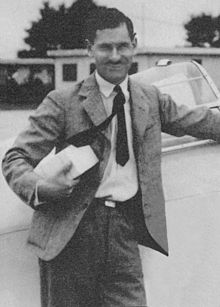A. E. Clouston
| A.E. Clouston | |
|---|---|

A.E. Clouston, September 1936
|
|
| Born |
7 April 1908 Motueka, New Zealand |
| Died | 1 January 1984 (aged 75) St Merryn, Padstow, Cornwall |
| Allegiance | United Kingdom |
| Service/branch | Royal Air Force |
| Years of service | 1930–1935 1939–1960 |
| Rank | Air Commodore |
| Commands held |
Aeroplane and Armament Experimental Establishment (1957–60) Empire Test Pilots' School (1950–54) RAF Leeming (1950) RNZAF Base Ohakea (1947–49) RAF Bückeburg (1945–47) RAF Langham (1944–45) No. 224 Squadron (1943–44) |
| Battles/wars | Second World War |
| Awards |
Companion of the Order of the Bath Distinguished Service Order Distinguished Flying Cross Air Force Cross & Bar |
Air Commodore Arthur Edmond Clouston, CB, DSO, DFC, AFC & Bar (7 April 1908 – 1 January 1984) was a British test pilot and senior Royal Air Force officer who took part in several air races and record-breaking flights in the 1930s.
Arthur Clouston was born on 7 April 1908 at Motueka, New Zealand, the eldest of nine children of mining engineer Robert Edmond Clouston (1874–1961) and his wife Ruby Alexander Scott (1886–1943). As a teenager, Arthur developed engineering and practical country skills, and established a business repairing and reselling motor cars. His ambition was to be a master mariner, but that was abandoned due to incurable seasickness.
He was inspired by the expansion of aviation, and particularly the pioneering flights in Australia and New Zealand by aviators such as Charles Kingsford-Smith and C.W.A. Scott in the late 1920s. He learned to fly at the Marlborough Aero Club at Omaka Aerodrome, near Blenheim. In 1930, after failing his attempt to join the Royal New Zealand Air Force, he moved to the United Kingdom.
In 1930, after arriving in England, Clouston found that there was a waiting list to join the RAF, so he then joined Fairey Aviation Company as a working student. Applications to the RAF were repeatedly halted, until it was found that his blood pressure was lower during flying than while awaiting medical examinations on the ground. In October 1930, he joined No. 3 FTS at RAF Spitalgate, where he went solo after about two hours flying. In April 1931, he was posted as pilot officer to No. 25 Squadron at RAF Hawkinge, flying Hawker Fury I fighter biplanes.
...
Wikipedia
